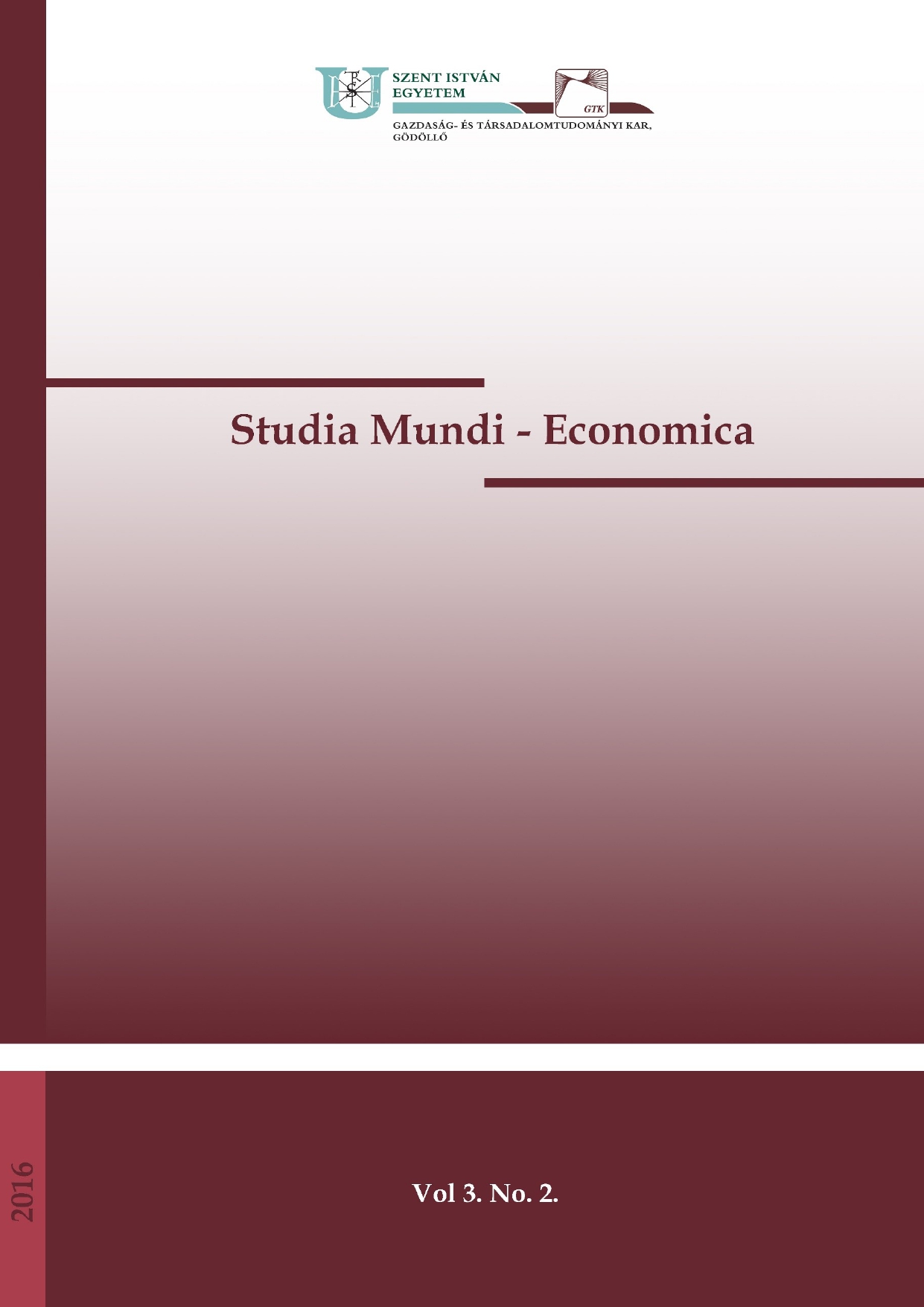The importance of halting urban sprawls in regional development
DOI:
https://doi.org/10.18531/Studia.Mundi.2016.03.02.90-100Keywords:
városszétfolyás, felszínborítás, földhasználat, területfejlesztésAbstract
Urban sprawl is a typical „sickness” in the United States, and, although it is not as widespread in Europe, there are some examples of it here, too. It causes many problems: environmental, health-related, financial and city-planning challenges, which must be treated and prevented. There are many ways to do so, and this study deals with two of them: the compact city and the slow city models. Both models differ from the traditional city models, and neither of them ensures success. However, both can improve and rationalise the operation of the city, if planned properly.
References
Breheny, M. (1995) Compact cities and transport energy consumption, Transanctions of the Institute of British Geographers, vol 20, no 1, pp91-101
Brueckner, J. K. (2000): Urban sprawl: diagnosis and remedies. International Regional Science Review, Vol. 23, no. 2, pp 160-171.
Citislow.uk weboldal (n.d.): Goals. Internetes elérhetőség: http://www.cittaslow.org.uk/about-us/goals/ . [Letöltve: 2016.10.22.]
Dantzig G. B., Saaty T. L. (1974): Compact City : A Plan for a Livable Urban Environment. Transportation Science, Vol. 9, No. 1 (February 1975), pp. 91-97
Díaz-Pacheco, J., García-Palomares, J. C. (2014): Urban sprawl in the Mediterranean urban regions in Europe and the crisis effect on the urban land development: Madrid as study case. Urban Studies Research, vol. 2014
Európai Környezetvédelmi Ügynökség (2006): Urban Sprawl in Europe. The ignored challenge. Joint Research Centre, European Environment Agency, Copenhagen. 60 p.
Európai Tanács (1983): European Regional/Spatial Planning Charter. Internetes elérhetőség:
http://81.47.175.201/flagship/index.php?option=com_content&view=article&id=625:european-regionalspatial-planning-charter-torremolinoscharter&catid=109:policies&Itemid=156 [Letöltve: 2016.01.12.]
Ewing, R. (1997): Is Los Angeles-style sprawl desirable? Journal of the American Planning Association, vol. 63, no. 1, pp. 107–126.
Frumkin, H. (2002): Urban sprawl and public health. Public Health Reports, Vol. 117, pp. 201-217.
Galster, G., Hanson, R., Ratcliffe, M. R., Wolman, H., Coleman, S., Freihage, J. (2001): Wrestling sprawl to the ground: defining and measuring an elusive concept. Housing Policy Debate, vol. 12, no. 4, pp. 681–717.
Gunduz, C., Oner, A. C., Knox, P. L. (2016): Social Resilience in Aegean Slow Cities: Slow City Seferihisar. Universal Journal of Management 4(4): 211- 22
Gutfreund, O. D. (2004): 20th-century sprawl – highways and the reshaping of the American landscape. Oxford University Press, Oxford, 231 p.
Holtzclaw, J., Clear, R., Dittmar, H., Goldstein, D., Haas, P. (2002): Location efficiency: neighborhood and socio-economic characteristics determine auto ownership and use –studies in Chicago, Los Angeles, and San Francisco. Transportation Planning and Technology, Vol. 25, no. 1, pp. 1-27.
Káposzta, J. (2014): Területi különbségek kialakulásának főbb összefüggései. Gazdálkodás, 2014, no. 58, pp. 399-412.
Káposzta, J., Nagy, H. (2015): Status Report about the Progress of the Visegrad Countries in Relation to Europe 2020 Targets. European Spatial Research and Policy, 2015, no. 22, pp. 81-99.
Káposzta, J., Nagy, H., Kollár, K. (2010): Borsod-Abaúj-Zemplén és Szabolcs-SzatmárBereg megye leghátrányosabb helyzetű kistérségeinek települési szerkezeti, foglalkoztatási jellemzői az EU csatlakozás óta eltelt időszakban. Területi statisztika. 13. (50.) évfolyam 6. szám. 2010. november. ISSN 0018-7828. pp. 641-658.
Keserű, I. (2005): Owen D. Gutfreund: 20th-century sprawl – highways and the reshaping of the American landscape. Tér és Társadalom, vol. 19, no. 1, pp. 167-170.
Kovács, F. (2009): Területhasználati változások a településegyüttes térségében –távérzékelési módszerek interpretációja. In.: Ricz, J., Salamin, G., Sütő, A., Hoffmann, Cs., Gere, L. (2009): Koordinálatlan városnövekedés az együtt tervezhető térségekben: A települések lehetséges tervezési válasza. Kutatási jelentés. VÁTI, Budapest. pp. 58-78.
Lewis Historical Society (2011): Urban sprawl versus new urbanism. Available from: http://lewishistoricalsociety.com/wiki2011/tiki-read_article.php?articleId=94
Liu, X., Jiang, B. (2011): A novel approach to the identification of urban sprawl patches based on the scaling of geographic space. International Journal of Geomatics and Geosciences, Vol 2., no. 2., pp 1-15
Mayer, H., Knox, P. L. (2006): Slow cities: Sustainable places in a fast world. JOURNAL OF URBAN AFFAIRS, Volume 28, Number 4, pages 321–334. ISSN: 0735-2166.
Nechyba T. J., Walsh R. P. (2004): Urban sprawl. Journal of Economic Perspectives, Vol 18, no. 4, pp 177 200Ricz J., Salamin G., Sütő A., Hoffmann Cs., Gere L. 2009. Koordinálatlan városnövekedés az együtt tervezhető térségekben: A települések lehetséges tervezési válasza. Kutatási jelentés. VÁTI, Budapest. p. 170.
OECD.org (n.d.): Compact City Policies: A Comparative Assessment. Internetes elérhetőség: https://www.oecd.org/greengrowth/greening-cities-regions/compactcity.htm#k_facts [Letöltve: 2016.10.27.]
Péli T., Neszmélyi Gy. I. (2015): Territorial differences of rural cities and the development of transport infrastructure in Hungary. Romanian review of regional studies, 2015, no. 2, pp. 51-66.
Pink, S., Lewis, S. T. (2014): Making resilience: every day affect and global affiliation in Australian Slow Cities, Cultural Geographies, February 2014, pp. 1-16, 2014
Salamin G., Sütő A., Kovács F. 2009. A koordinálatlan (nagy)városi terjeszkedés területszervezési kérdései Magyarországon. In. Szabó V.; Fazekas I. (szerk.) Települési Környezet. A II. Települési Környezet Konferencia kötete. Tájvédelmi és Környezetföldrajzi Tanszék, Debrecen. pp. 203-210.
Slowcitymovement.com (n.d.): Slow cities. Internetes elérhetőség: http://www.slowmovement.com/slow_cities.php. [Letöltve: 2016.10.23.]
Downloads
Published
Issue
Section
License
Copyright (c) 2016 Topa Zoltán

This work is licensed under a Creative Commons Attribution-NonCommercial-NoDerivatives 4.0 International License.
A folyóirat Open Access (Gold). Cikkeire a Creative Commons 4.0 standard licenc alábbi típusa vonatkozik: CC-BY-NC-ND-4.0. Ennek értelmében a mű szabadon másolható, terjeszthető, bemutatható és előadható, azonban nem használható fel kereskedelmi célokra (NC), továbbá nem módosítható és nem készíthető belőle átdolgozás, származékos mű (ND). A licenc alapján a szerző vagy a jogosult által meghatározott módon fel kell tüntetni a szerző nevét és a szerzői mű címét (BY).






